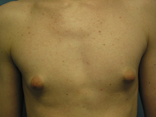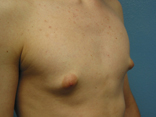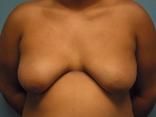Home|Breast Procedures|Male Breast Reduction (Surgery for Gynecomastia)
Male Breast Reduction (Surgery for Gynecomastia)
Gynecomastia refers to the condition where there is the development of enlarged breasts in males. Despite the fact that it is a relatively common occurrence, gynecomastia frequently is associated with mental distress, embarrassment, low self-esteem, depression and insecurity. The impact on daily activities, social interactions and dating can be dramatic, particularly in boys and younger men. Otherwise inconsequential acts such as removing one’s T-shirt when jogging, playing sports or even swimming can be quite stressful and even somewhat traumatic. Many men will wear very loose fitting clothes or multiple layers, even in hot weather, in order to camouflage their “deformity.”
Scottsdale plastic surgeon Steven Turkeltaub, MD understands how embarrassing and problematic gynecomastia can be for those who have it. He offers male breast reduction surgery to help patients obtain a more masculine chest contour and improve their self-confidence.
- What Is Gynecomastia?
- Causes of Gynecomastia
- Gynecomastia Symptoms
- Examples of Gynecomastia
- Difference Between Gynecomastia and Pseudogynecomastia
- Gynecomastia vs. Male Breast Cancer
- Does Health Insurance Cover the Treatment of Gynecomastia?
- Can Gynecomastia Be Treated with Exercise?
- Surgical Techniques for Male Breast Reduction
- Your Surgery for Treatment of Gynecomastia
- Recovery from Surgery for Gynecomastia
- Will I Have Scars After Gynecomastia Treatment?
- How Much Does Male Breast Reduction Cost?
- Male Breast Reduction Before-and-After Photos
- Frequently Asked Questions
- Additional Information About Breast Reduction from Dr. Turkeltaub’s Blog
What Is Gynecomastia?
Gynecomastia is a condition characterized by breast enlargement in males. It is quite common for adolescent males to experience this during puberty as a result of hormonal fluctuations. However, this condition naturally resolves on its own for the vast majority of those who are affected.
Male breast enlargement also develops in adult males, for a variety of reasons, which can lead to decreased confidence and embarrassment as well
What Causes Gynecomastia?
The most common etiology of this condition relates to the effects of elevated hormonal levels occurring during puberty. A majority of these enlargements do spontaneously resolve following puberty. There are many other causes of gynecomastia including:
- Obesity
- Steroid abuse
- Medication side effects
- Illicit drugs such as marijuana
- Hormonal imbalances such as caused by tumors
- Chronic liver disease
- Genetic disorders
- Aging
What Are the Symptoms of Gynecomastia?
The primary symptom of gynecomastia is the enlargement of glandular tissue in the breasts. Though most often occurring in both breasts, on occasion it may just be present on one side. There can also be asymmetric involvement with one side significantly larger than the other.
In many individuals, this abnormal breast tissue growth is often accompanied by excess fat. In extreme cases, there may be a relative excess of lax skin associated with drooping of the breasts and cup sizes that can be a “C,” “D” or even larger.
Infrequently, tenderness of the breasts is present. It is extremely rare that this enlargement is associated with substantial pain.
Examples of Gynecomastia
The extent of the enlargements can range from being imperceptible to all but the male involved to massive, overly projecting, drooping double D or larger breasts.
Mild Gynecomastia in a 16 year old male with
enlargement localized to the areola area.
Severe Gynecomastia in a 14 year old male
What Are the Differences Between Gynecomastia and Pseudogynecomastia?
Though the term “gynecomastia” has been generalized to include male breast enlargement of any cause, it more correctly applies to those whose condition is due to excessive breast tissue. When the breast enlargement is largely due to the accumulation of fat, it is more appropriately categorized as “pseudogynecomastia”.
In true gynecomastia, extra glandular tissue is the main cause of the enlarged breasts. Often manifesting during puberty as a result of hormonal fluctuations, this accumulation of tissue typically resolves naturally for most males. However, in the event that this condition does not resolve on its own, the most effective treatment is direct surgical excision of the excess glandular tissue. This is also true for other causes of this condition.
In pseudogynecomastia, the primary issue for the enlarged male breasts is an excessive volume of fatty tissue, which is often the result of obesity. Some males may find that diet, weight loss and exercise (including certain chest-related weight lifting techniques) helps to improve pseudogynecomastia, but the majority of individuals require fat removal via liposuction in order to comprehensively address this problem.
Since true gynecomastia and pseudogynecomastia can have similar appearances, distinguishing between the two conditions is not always possible until the time of surgery. For this reason, selecting a board-certified plastic surgeon who is highly proficient and experienced in both direct tissue excision and liposuction is essential to helping ensure that you receive the safest, most effective and thorough treatment and the best possible outcome.
Gynecomastia vs. Male Breast Cancer
According to the National Institutes of Health (NIH), about one percent of all breast cancers occur in men. Fortunately, gynecomastia has never been shown to be associated with an increased risk for breast cancer. Nevertheless, it is important to discern the differences in glandular tissue in gynecomastia versus male breast cancer.
Gynecomastia due to glandular tissue presents as a smooth, firm growth underneath the nipple and/or areola, often extending peripherally. This condition may be present in one or both breasts and can be associated with some tenderness. On the other hand, male breast cancer typically appears as an irregular growth with a rubbery or hard feel. The tumor can form anywhere in the breast, including underneath the nipple, but breast cancer is more likely to be confined to one breast as opposed to both.
For those who are unsure of or are concerned about any irregularities found on their chest, it is strongly recommended to have a qualified medical professional perform an evaluation. When detected early, the success rate of breast cancer treatment in men can be quite high.
As for gynecomastia, when male breast reduction is skillfully performed by a board-certified plastic surgeon, the outcome can be quite dramatic and rewarding—physically and mentally.
Does Health Insurance Cover the Treatment of Gynecomastia?
Considering it to be an aesthetic issue, insurance companies do not provide coverage for the surgical treatment of gynecomastia. Dr. Turkeltaub does offer special and affordable package pricing in conjunction with the outpatient center and the anesthesiologist that can help make your surgical treatment a reality.
Can Gynecomastia Be Treated with Exercise?
Unfortunately, male breast reduction surgery is needed to fully address gynecomastia close to one hundred percent of the time. For men whose enlarged breasts are largely related to obesity, weight loss and exercising can be very effective in improving the appearance of the breasts but usually do not completely eradicate the problem. For this reason, male breast reduction surgery is considered the definitive treatment for the vast majority of these individuals.
When the main cause of gynecomastia is glandular tissue (with or without the presence of some excess fat), exercise alone will definitely not resolve the condition. In these situations, the direct excision of the breast tissue is mandatory in order to obtain a desirable outcome. If there is also some fat contributing to the enlargement, this component can be removed using liposuction.
What Are the Different Surgical Techniques for Male Breast Reduction?
Men with gynecomastia have variable and increased amounts of fat and glandular tissue. Those who are obese tend to have a greater proportion of fat and will see benefits from weight loss though it usually doesn’t fully eradicate the problem. With extreme enlargements, there can also be a relative excess of skin, possibly even with drooping.
The definitive treatment for gynecomastia is surgery aimed at removing the extra tissue and recontouring the breasts. Fortunately, the results can be quite successful and dramatic. When the underlying cause is solely the presence of prominent glandular tissue, treatment involves direct excision of this tissue using an incision around the lower half of the areola. If fat is the reason for the gynecomastia, the appropriate treatment would be to use liposuction. With this technique, one or two small incisions generally are employed per side (usually less than 3/8″ each) in order to facilitate the fat removal. They can be placed along the lower part of the nipple, in the crease at the bottom of the breast or even in the armpit.
Not infrequently, both fat and glandular tissue contribute to the gynecomastia. In such situations, treatment would entail a combination of both direct excision of the excess glandular tissue and the removal of fat by liposuction.
In the relatively rare situations where the breasts are massively enlarged, droopy and there is an abundance of excess skin with poor elasticity, then a much more extensive procedure with lengthy incisions needs to be considered in order to obtain appropriate correction.
What Can I Expect From the Male Breast Reduction Procedure?
The surgery to reduce the size of your breasts is done under general anesthesia as an outpatient and typically takes two hours or less. If there is skin excess and even drooping that needs to be addressed, operative time can be longer.
Depending on the cause of your male breast growth, Dr. Turkeltaub directly excises excess glandular tissue and/or utilizes liposuction to remove excess fatty tissue, restoring a flatter, more masculine chest contour that one can be proud of. Many men frequently combine this with other cosmetic procedures, particularly liposuction of their love handles and abdomen.
What Is Recovery Like After Gynecomastia Treatment?
A compressive dressing will be placed at the time of your surgery which will help to minimize bruising, discomfort and swelling. After two to three days, it is replaced in the office with a snug fitting elastic sports shirt, like Under Armor®, which is worn most of the time for several weeks.
Discomfort is generally mild and usually well controlled with oral pain medication, if needed. Many patients can return to work or school or work within a few days and resume sports and working out at around 3 – 4 weeks or longer. It may take from six months to a year for all the swelling to maximally resolve.
Will I Have Scars After Gynecomastia Treatment?
As with any surgical procedure where an incision is made in the skin, there will be a scar of some type. Dr. Turkeltaub most commonly uses incisions placed either along the lower part of the nipple or in the crease at the lower part of the breast. Using his extensive expertise to blend the incision lines into the natural contours of the chest, the scars that result heal extremely well and are largely inconspicuous virtually all of the time.
How Much Does Male Breast Reduction Cost?
As with most plastic surgical treatments, the total cost of male breast reduction surgery will include fees for the surgeon, anesthesia and usage of the surgical facility, whether it is an office, hospital or outpatient center. In addition to these expenses, the following factors can also impact the overall price of the procedure:
- The general geographical area in which the practice is located and/or the surgery is performed
- The credentials, skill, personal preferences and experience of the plastic surgeon
- The surgical technique employed by the physician (tissue excision, liposuction or both)
- The number of available surgical facilities in the region, as well as the particular facility selected
- Any postoperative medication that may not be fully or partially covered by insurance
- The current state of the economy
Since gynecomastia is considered to be an aesthetic issue in virtually all situations, the male breast reduction procedure is rarely covered by health insurance which means that patients will likely be responsible for paying all expenses out-of-pocket. In order to help make treatment more affordable, Dr. Turkeltaub’s practice partners with trusted third-party lending companies like CareCredit® to offer various breast enhancement financing and payment plan options.
For a personalized estimate of what your gynecomastia treatment may cost, please schedule a consultation with Dr. Turkeltaub. Based on a thorough assessment of your specific needs and goals, he will be able to provide a close approximation of the overall cost of your male breast reduction procedure.
Male Breast Reduction Before-and-After Photos
The psychological and physical benefits that occur as a result of undergoing surgery to correct male breast enlargement can be quite profound and rewarding.
Frequently Asked Questions
Is it rare for a man to have enlarged breasts?
What happens to the extra skin after gynecomastia treatment?
How soon after male breast reduction surgery can I return to work?
Will I have drains following my male breast reduction surgery?
Additional Information About Male Breast Reduction (Gynecomastia) from Dr. Turkeltaub
Read more about male breast reduction (gynecomastia) on Dr. Turkeltaub’s breast surgery blog.
Learn More About Gynecomastia Treatment
If you would like to learn more about gynecomastia treatment or to schedule an appointment with Dr. Turkeltaub, you can contact us at the Arizona Center for Breast Surgery.




